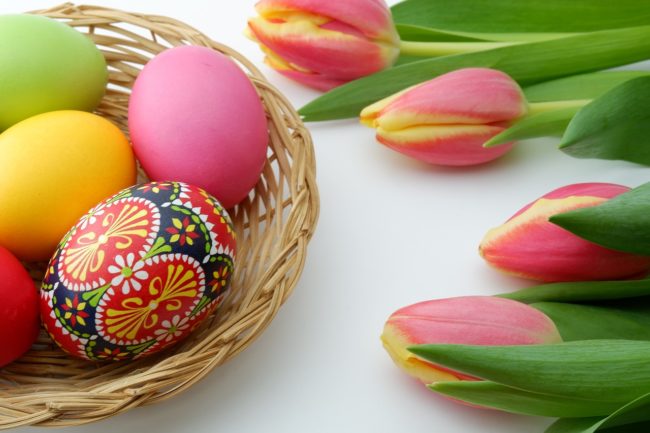SUNDAY, APRIL 21, and SUNDAY APRIL 28: EASTER is the most important Christian celebration of the year in both Eastern (Orthodox) and Western churches—but the two branches of Christianity will mark the date one week apart this year.
Hot cross buns, chocolate bunnies and brunch soufflé fill tables and baskets of plenty on this joyous holiday, as families and friends gather to mark this, the focal point of the Christian calendar. Lilies adorn altar spaces and remind churchgoers both of resurrection (blossoms from dormant spring bulbs)—and that Jesus enjoyed a form of lily himself as is evidenced in the Gospel of Luke. The 50 days following Easter are called Eastertide.
(Note: Though termed Pascha in the Eastern Christian Church, the themes are similar across East and West.)
EGG HUNTS AND HAM TO BELLS AND LAMB
Easter in America may be characterized as much by the Easter Bunny and pastel-hued candies as it is by Christian joy in Christ’s Resurrection. Egg hunts, treat-filled baskets and festive brunches mark Easter for many American families, although for Christians, shared meals most often involve white-and-gold settings, fresh lilies on the table and, in many homes, a sacred Paschal Candle. A traditional Easter menu also often features lamb—a symbol of Christ at this time of year as the Paschal Lamb. However, these days, Easter hams far outpace cuts of lamb. Whether at church or at a post-service feast, Christians dress in their best apparel on Easter day.
In France and Belgium, the bells that “went to Rome on Maundy Thursday” return home for the evening Easter Vigil, only to bring Easter eggs to boys and girls—or so, the story has it.
In most countries with a substantial Christian population, Easter is a public holiday.
THE NEW TESTAMENT: WITNESS OF AN EMPTY TOMB
The New Testament describes the events of the resurrection of Jesus, which Christians believe verify him as the Son of God. There is no recorded “moment of resurrection,” but rather, the discovery by Mary Magdalene (and possibly others) early on Sunday morning—that the tomb was empty.
Did you know? First evidence of the Easter festival appears in the mid-2nd century.
In his crucifixion, Jesus died on a Roman cross. That evening, according to Christian tradition, Joseph of Arimathea asked for the body, wrapped it in linen cloth and laid it in a tomb. Saturday passed, and early on Sunday morning, Mary Magdalene (and, some Gospels attest, other women in attendance) visited the tomb of Jesus. Much to their surprise, the tomb’s stone was moved, and a messenger announced that Jesus had risen from the dead. Gospel accounts vary regarding the messenger’s specific message and the women’s response, but all emphasize that the empty tomb was witnessed. To this day, sunrise services are popular in some regions on Easter Sunday, echoing the traditional stories of the empty tomb.
In the church, Easter is followed by the 50 days of Eastertide, which comes to an end on Pentecost Sunday.
EASTER RECIPES, DIY & MORE
- Feeding a crowd—or a few? Flavorful recipes for pastries, elaborate egg dishes and even a bunny house are at Food Network.
- Marbleized, glittering and chalkboard eggs are a snap to create, thanks to tips from Martha Stewart, Reader’s Digest and Home and Garden Network.
- Glow-in-the-dark eggs for a nighttime hunt are more feasible than they might sound: Wiki How offers instructions.
- Set your Easter table a little more creatively this year, with help from HGTV.
- Homemade chocolate Easter eggs are made easy, thanks to directions from the BBC.

